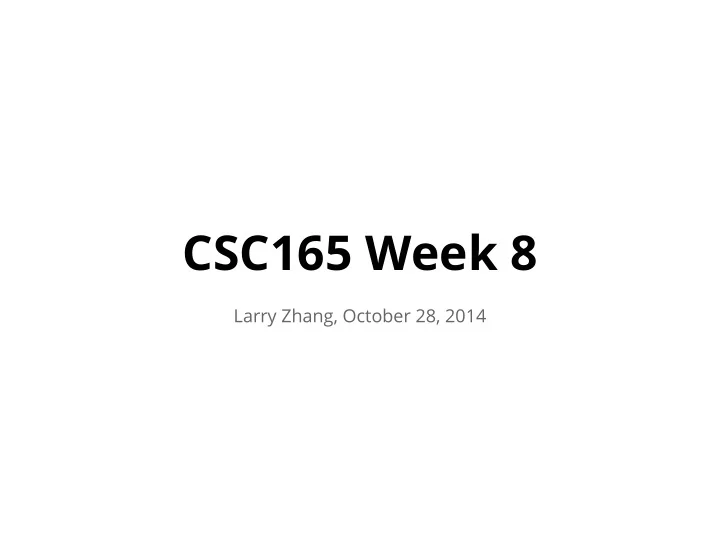

CSC165 Week 8 Larry Zhang, October 28, 2014
today’s outline ➔ formal definition of O, Ω ➔ proving algorithm complexity ➔ problem solving session
formal definitions of O and Ω
recap O(n²) set of functions that grow no faster than n² ➔ count the number of steps ➔ constant factors don’t matter ➔ only highest-order term matter These functions are in O(n²)
the formal definition of O(n²) Beyond breakpoint B , cn² f(n) is upper-bounded by cn² , where c is some f(n) wisely chosen constant multiplier. B
the formal definition of O(n²) Simple example: prove 700n² ∈ O(n²)
the formal definition of Ω(n²) O(n²): set of functions that grow no faster than n² Ω(n²): set of functions that grow no slower than n² ϴ (n²): set of functions that are in both O(n²) and Ω(n²) (functions growing as fast as n² )
growth rate ranking of typical functions grow fast grow slowly
analyse a sorting algorithm
insertion sort ➔ grow a sorted list inside an unsorted list ➔ in each iteration ◆ remove an element from the unsorted part ◆ insert it into the position it belongs to in the sorted part see animation at: http://en.wikipedia.org/wiki/Insertion_sort
insertion sort def IS(A): ‘’’sort the elements in A in non-decreasing order’’’ n: size of A 1. i = 1 2. while i < len(A): 3. t = A[i] # take red square out 4. j = i 5. while j > 0 and A[j-1] > t: 6. A[j] = A[j-1] # shift 7. j = j - 1 8. A[j] = t # put red square in 9. i = i + 1 # next element to be red-squared
insert sort worst case runtime
Prove the worst case complexity of insertion sort is O(n²) Proof:
analyse another algorithm
maximum slice ➔ input: L , a list of numbers ➔ output: the maximum sum over slices of L L = [-2, -3, 4, -1, 6, -3] max = 4 + (-1) + 6 = 9
def max_sum(L): ‘’’ maximum sum over slices of L’’’ 1. max = 0 2. i = 0 3. while i < len(L): 4. j = i + 1 5. while j <= len(L): 6. sum = 0 7. k = i 8. while k < j: 9. sum = sum + L[k] 10. k = k + 1 11. if sum > max: 12. max = sum 13. j = j + 1 14. i = i + 1 15. return max
def max_sum(L): ‘’’ maximum sum over slices of L’’’ upper bound W MS (n) 1. max = 0 # line 8-10, at most n iters 2. i = 0 3. while i < len(L): 4. j = i + 1 # line 5-13, at most n iters 5. while j <= len(L): 6. sum = 0 7. k = i 8. while k < j: 9. sum = sum + L[k] # line 3-14, at most n iters 10. k = k + 1 11. if sum > max: 12. max = sum 13. j = j + 1 14. i = i + 1 # line 3-14, at most n iters 15. return max
def max_sum(L): ‘’’ maximum sum over slices of L’’’ lower bound W MS (n) 1. max = 0 0 n-1 L: 2. i = 0 3. while i < len(L): # first loop (i), at least 4. j = i + 1 iterations. 5. while j <= len(L): (pick i in red zone) 6. sum = 0 7. k = i # second loop (j), at least 8. while k < j: iterations 9. sum = sum + L[k] (pick j in blue zone) 10. k = k + 1 11. if sum > max: # third loop (k), at least 12. max = sum iterations 13. j = j + 1 (slice [i:j] is at least this long) 14. i = i + 1 15. return max
takeaway ➔ when finding upper-bound , it is OK to over-estimate the number of steps, as long as the over-estimated number is upper bounded. ➔ when finding lower-bound , it is OK to under-estimate the number of steps, as long as the under-estimated number is lower-bounded
problem solving: penny piles
Recommend
More recommend